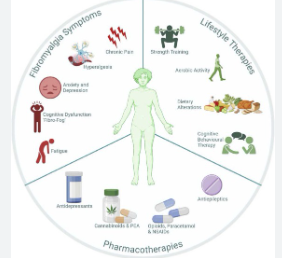What is the Best Lifestyle for Fibromyalgia?
Living Well with Fibromyalgia: What is the Best Lifestyle for Fibromyalgia?
Fibromyalgia is a long-term condition that causes widespread pain, fatigue, sleep disturbances, and cognitive issues. Although there is no known cure, the right lifestyle changes can significantly ease the symptoms and improve quality of life. Understanding what is the best lifestyle for fibromyalgia means creating a daily routine that addresses the body’s physical, emotional, and mental needs. A well-rounded approach that incorporates diet, movement, rest, stress management, and social support can provide lasting relief and promote resilience.
The Role of Daily Routine and Structure
Living with fibromyalgia often involves managing unpredictable flares and persistent discomfort. Establishing a consistent daily routine helps reduce stress and stabilize symptoms. Wake-up and sleep times should remain steady every day, including weekends. Planning meals, medication, light activities, and breaks at set times offers the body predictability, which can soothe the nervous system and reduce fatigue.
Nutrition and Diet for Symptom Relief
What you eat can influence inflammation, energy levels, and pain perception. While there is no one-size-fits-all fibromyalgia diet, certain principles benefit most individuals with the condition.
- Whole Foods Focus: Emphasize fresh fruits, vegetables, whole grains, lean proteins, and healthy fats.
- Reduce Processed Foods: Minimize sugar, artificial additives, and highly processed snacks.
- Limit Trigger Foods: Some people with fibromyalgia report sensitivity to gluten, dairy, or caffeine. Keeping a food diary can help pinpoint specific triggers.
- Stay Hydrated: Drinking enough water supports joint lubrication, circulation, and energy.
A balanced diet fuels the body and brain, reduces inflammation, and supports overall well-being.
Gentle and Consistent Physical Activity
Exercise can be intimidating for people with chronic pain, but it’s a vital part of the best lifestyle for fibromyalgia. The goal is not intensity, but consistency and gentleness. Movement helps loosen stiff muscles, boost endorphins, and promote better sleep.
- Low-Impact Activities: Walking, swimming, water aerobics, tai chi, and yoga are excellent options.
- Pacing: Avoid overexertion by gradually increasing duration and intensity.
- Stretching: Daily stretching can reduce stiffness and improve flexibility.
Physical activity tailored to energy levels helps reduce flare-ups and increases confidence in managing the body’s capabilities.
Sleep Hygiene and Restorative Rest
Poor sleep is one of the most disruptive symptoms of fibromyalgia. Creating a sleep-friendly environment and adopting calming routines can lead to more restful nights.
- Consistent Sleep Schedule: Go to bed and wake up at the same time every day.
- Sleep Environment: Keep the room cool, dark, and quiet.
- Limit Stimulants: Avoid caffeine, alcohol, and screen time before bed.
- Wind Down: Gentle stretching, reading, or warm baths can signal the body to relax.
Improving sleep quality enhances energy, mood, and pain thresholds during the day.
Managing Stress and Emotional Wellness
Stress is a well-known trigger for fibromyalgia symptoms. Therefore, managing emotional health is a cornerstone of an effective lifestyle strategy.
- Mindfulness and Meditation: These practices promote relaxation and awareness, reducing anxiety and pain intensity.
- Counseling and Support Groups: Talking with others, whether friends, therapists, or support communities, can reduce isolation and offer practical coping tools.
- Creative Outlets: Activities like journaling, painting, or music can provide emotional expression and mental distraction from pain.
Taking care of mental health supports the nervous system and creates emotional stability.
Work-Life Balance and Setting Boundaries
Maintaining balance between activity and rest is key. Individuals with fibromyalgia must learn to set realistic limits without guilt.
- Say No When Needed: Prioritize energy for essential tasks and decline activities that lead to burnout.
- Break Tasks into Steps: Simplify household chores, shopping, or work assignments into manageable parts.
- Use Assistive Tools: Ergonomic tools, planners, and timers can help conserve energy and avoid overexertion.
Adopting boundaries prevents flares and empowers individuals to protect their well-being.
Social Connections and Support Systems
Isolation can increase stress and depression, both of which can worsen fibromyalgia. Maintaining relationships, even in small ways, contributes to emotional health.
- Stay Connected: Schedule regular chats with friends and family.
- Join Support Groups: Sharing experiences with others who understand fibromyalgia can be validating and encouraging.
- Communicate Openly: Educate close ones about the condition and how they can offer support.
Supportive relationships provide motivation and compassion, both essential for healing.
Conclusion The best lifestyle for fibromyalgia is not about perfection but about progress and balance. It involves making intentional choices each day that support the body’s needs and reduce the burden of symptoms. From a nourishing diet to mindful movement, from restful sleep to meaningful connections, every lifestyle choice creates a foundation for resilience and relief. While fibromyalgia presents unique challenges, the right lifestyle empowers individuals to live with strength, purpose, and hope.



